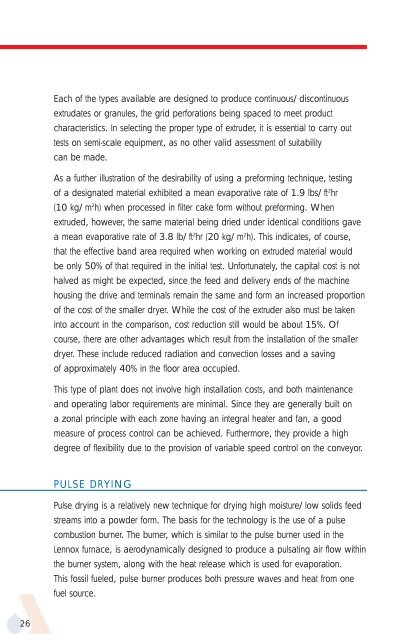APV Dryer Handbook - Umbc
APV Dryer Handbook - Umbc
APV Dryer Handbook - Umbc
Create successful ePaper yourself
Turn your PDF publications into a flip-book with our unique Google optimized e-Paper software.
26<br />
Each of the types available are designed to produce continuous/discontinuous<br />
extrudates or granules, the grid perforations being spaced to meet product<br />
characteristics. In selecting the proper type of extruder, it is essential to carry out<br />
tests on semi-scale equipment, as no other valid assessment of suitability<br />
can be made.<br />
As a further illustration of the desirability of using a preforming technique, testing<br />
of a designated material exhibited a mean evaporative rate of 1.9 lbs/ft2hr (10 kg/m2h) when processed in filter cake form without preforming. When<br />
extruded, however, the same material being dried under identical conditions gave<br />
a mean evaporative rate of 3.8 lb/ft2hr (20 kg/m2h). This indicates, of course,<br />
that the effective band area required when working on extruded material would<br />
be only 50% of that required in the initial test. Unfortunately, the capital cost is not<br />
halved as might be expected, since the feed and delivery ends of the machine<br />
housing the drive and terminals remain the same and form an increased proportion<br />
of the cost of the smaller dryer. While the cost of the extruder also must be taken<br />
into account in the comparison, cost reduction still would be about 15%. Of<br />
course, there are other advantages which result from the installation of the smaller<br />
dryer. These include reduced radiation and convection losses and a saving<br />
of approximately 40% in the floor area occupied.<br />
This type of plant does not involve high installation costs, and both maintenance<br />
and operating labor requirements are minimal. Since they are generally built on<br />
a zonal principle with each zone having an integral heater and fan, a good<br />
measure of process control can be achieved. Furthermore, they provide a high<br />
degree of flexibility due to the provision of variable speed control on the conveyor.<br />
PULSE DRYING<br />
Pulse drying is a relatively new technique for drying high moisture/low solids feed<br />
streams into a powder form. The basis for the technology is the use of a pulse<br />
combustion burner. The burner, which is similar to the pulse burner used in the<br />
Lennox furnace, is aerodynamically designed to produce a pulsating air flow within<br />
the burner system, along with the heat release which is used for evaporation.<br />
This fossil fueled, pulse burner produces both pressure waves and heat from one<br />
fuel source.











